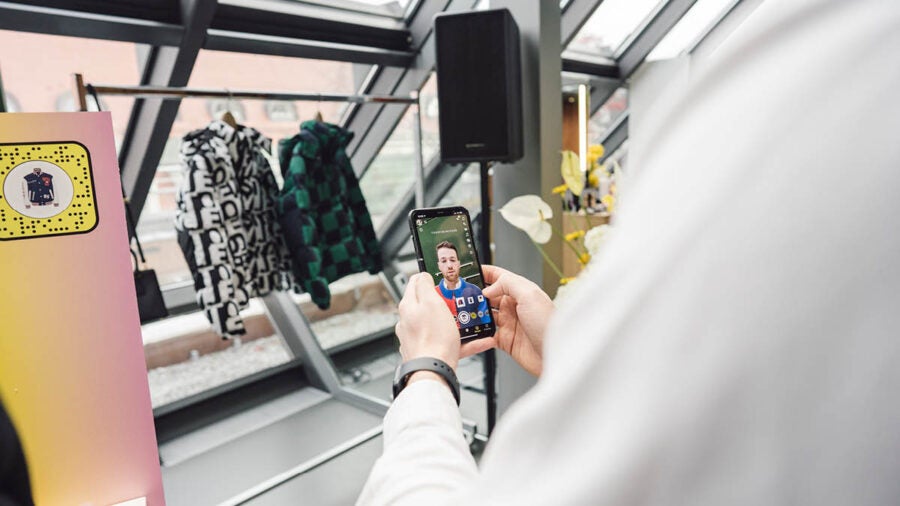
Augmented reality (AR) is fast becoming a key component of consumer journeys.
Thanks in part to the Covid-19 pandemic, forward-thinking retailers have accelerated their efforts to replicate in-store experiences digitally. Ikea has built the capability to place furniture virtually in customers’ living rooms. Meanwhile, brands as diverse as Dior, Puma and Lego have all collaborated with Snap to augment their ecommerce offering.
Measuring [success] is the key. If you don’t have a way to measure it, then your CFO is never going to sign it off
While most brands have an online platform, only some take advantage of this format’s full potential. “[Augmented reality] is a far more engaging and personalised media format than static images or a video of an item,” says Fintan Gillespie, Snap’s head of UK Enterprise.
Gillespie sees AR as a solution to many of the problems brands face in the “broken” landscape of ecommerce where convenience is king and customer experience has taken a back seat. Shoppers are far more likely to leave a physical store having made a purchase; something augmented reality promises to change.
Shopify research has found that customers that interact with AR in online shopping ecosystems are 94% more likely to commit to a purchase. Additionally, 54% of consumers consider retail the ideal application of this technology.
“It’s personalised,” Gillespie explains. Customers have the opportunity to ‘try’ before they buy in a virtual setting, eliminating purchasing doubts to a large extent. “Engagement is so important. You get a feel of an item. The only other way you’re going to get that is by going into a physical store,” he says.
Retailers can now reach customers that have previously felt excluded. For example, the beauty industry has seen significant advances in inclusivity and safety as brands have integrated AR into online experiences. Users can accurately test the tone of makeup based on their skin colour or try out a new shade of lipstick without a physical sample. Tools like Snap’s ‘Inclusive Camera’ can make digital spaces more accessible.
Despite a positive reception from shoppers, some brands have been slow to adopt. The application of AR in ecommerce is still perceived as a novelty. Gillespie believes that many brands view this use of technology as “just for fun”, overlooking the potential value add to customer journeys that this can have.
He hypothesises that most brands don’t yet have the infrastructure to measure success in this area. “Measuring it is the key. If you don’t have a way to measure it, then your CFO is never going to sign it off,” says Gillespie.
However, the headline figures around increased conversion in the market at large should quickly change perspectives. Gillespie explains that late adopters haven’t missed the boat, and getting started is relatively simple.
Companies can start by testing success with a small sample of items. Then, by scanning images of their products and sending the information to third-party apps, 3D designers can quickly recreate the items digitally.
Snap achieves this for partners through an open-source platform called Lens Studio. Retailers send their product information through an API, at minimal cost and effort.
“It’s not difficult for a retailer to go and scan five items and get a proof of concept,” says Gillespie. “Put them on a landing page through the API’s that we provide, and then see whether users are buying at a higher rate. If that’s the case, your investment thesis is done.”
Crucially, retailers don’t have to build their own AR capability. Instead, consumers can interact with the solution outside the business’s existing ecommerce architecture. “It doesn’t matter where the touchpoint is as long as it happens,” says Gillespie. By leveraging the reach of third-party platforms, retailers can reach new consumers and gauge success using those platforms’ native analytics.
Brands that are using AR to create better shopping experiences are tapping into a golden opportunity to engage audiences and build tighter consumer relationships long-term. He concludes: “When you’re thinking about building customer relationships between a retailer and potential users, the engagement of the technology stands out. It’s just far superior to any other media type.”
For more information, visit forbusiness.snapchat.com/augmentalityshift-uk

Augmented reality (AR) is fast becoming a key component of consumer journeys.
Thanks in part to the Covid-19 pandemic, forward-thinking retailers have accelerated their efforts to replicate in-store experiences digitally. Ikea has built the capability to place furniture virtually in customers’ living rooms. Meanwhile, brands as diverse as Dior, Puma and Lego have all collaborated with Snap to augment their ecommerce offering.
Measuring [success] is the key. If you don’t have a way to measure it, then your CFO is never going to sign it off

